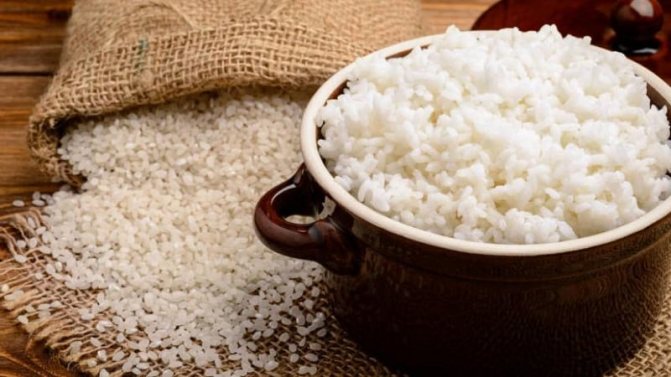Does this cereal have an expiration date?
Rice cereal is a food product, and, of course, it has an expiration date. Despite the fact that the product is not perishable, this does not mean that it can be stored indefinitely.
The law obliges manufacturers to comply with SanPiN standards, be sure to set expiration dates, and thereby guarantee compliance with the law “On the Protection of Consumer Rights”, the consumption of high-quality food by people, avoiding mass poisoning, and, as a result, disease epidemics. This responsibility is regulated by:
- GOST 6292-93 “Rice groats. Technical conditions".
- GOST 26791-2018 “Grain processing products. Packaging, labeling, transportation and storage."
- National standard R 55289-2012 “Fig. Technical conditions".
Rice becomes unsuitable for its intended use after the shelf life has expired, this is directly stated in regulations. The period is calculated from the moment the cereal is produced and depends on its type , as well as the region of origin.
Is it possible to eat expired rice?
Found a pack of expired rice in your strategic food supplies? Your case is not unique, every housewife sooner or later encounters cereals whose expiration date has expired before they were consumed for their intended purpose. Is it possible to eat them without harm to health and how can they be dangerous for the human body?
We recommend reading: How to Protect Preservation Lids from Rust
The average shelf life of rice is 13 – 15 months, the exact figure is always indicated on the product packaging. Before consuming expired cereal, it should be carefully inspected and sniffed; if its properties remain unchanged, the product can be thoroughly rinsed with hot water and boiled. However, this rule applies only to a slight excess of the expiration date.
Expired rice is rarely the cause of food poisoning, however, this does not mean that it should be eaten. The thing is that over time, the taste of the cereal changes, it becomes rancid or sour, and therefore it is not possible to enjoy it.
In addition, rice that has been sitting for a long shelf life ceases to be useful, since it simply does not contain vitamins and microelements. It is also quite common to come across the opinion that cereals, after the expiration date, accumulate various toxins and fungi, which can affect health in an extremely negative way.
The most interesting news:
Is it possible to get fat from buckwheat?
How many calories are there in 100 g of buckwheat? As much as 313 kcal. There is a lot of protein in porridge, at least...
Is it possible to fry champignons over a fire?
In any season, as soon as good weather appears, there is a desire to go into nature and please…
Is it possible to replace kefir with yogurt?
In many recipes for pies, pancakes, muffins and pies, kefir is a mandatory ingredient. So, for example...
In addition, rice that has been sitting for a long shelf life ceases to be useful, since it simply does not contain vitamins and microelements. It is also quite common to come across the opinion that cereals, after the expiration date, accumulate various toxins and fungi, which can affect health in an extremely negative way.
Marking
The responsibilities of each manufacturer include labeling (i.e., applying the required information to the product packaging indicating the properties and characteristics for the purpose of its further identification) of the product intended for sale to consumers. The expiration date is indicated on each package.
The date of manufacture and shift number are indicated by a seven-digit number in Arabic numerals and are printed on the surface of the package or on the label by printing with marking paint or stamping. Technical Regulations of the Customs Union 022/2011 require the manufacturer to indicate the number in the date of manufacture at its own discretion.
Marking is applied to the product in any way and must be clear and easy to read. These requirements are enshrined in the GOST 26791-2018 standard “Grain processing products. Packaging, labeling, transportation and storage."
Can I eat expired cereal?
Sometimes we store cereals for a long time or even buy ones that are already expired.
Which exit? Just throw it away or...
Starch is stored normally, unless it decomposes partially, but this is not critical, the molecules still remain large. Fiber and pectin substances too. But proteins can turn into toxic substances (various azo compounds) at high humidity. Fats can become carcinogenic (rancid) at elevated storage temperatures. So after the expiration date, legumes only go in the trash, various seeds and nuts go in the same place. And vermicelli, most cereals and cereals can be eaten.
Well, the smell, appearance and taste are the most important determinants of whether it can be eaten or not.
Is it possible to eat expired cereal?
If for food, it is undesirable. Even with a normal, non-expired expiration date, “animals” of various sizes can develop in an open package of cereals. The whole point is that in the warehouse where this cereal was stored, an infection occurred and these living creatures in larvae were packed in bags for sale. Even in a store, you should try to carefully examine the packaging. You may notice maggots and foreign debris. You wouldn’t recommend buying such cereals even to your enemy, since all your household cereal supplies will be infected.
We recommend reading: How to Freeze Mushroom Broth
If the cereal is expired, but in a normal, uninfected condition, you can use it as a foot massager . My child designed such a massager: he poured multi-colored beans and buckwheat into a box and periodically massages his feet - he really likes it!
Is it possible to eat expired cereal?
How long is the shelf life?
The current standard does not regulate clear expiration dates for cereals, indicating that they are established by the manufacturer in accordance with the regulatory documents of the state in whose territory they are valid.
Previously, in the text of GOST 26791-89 they were fixed - for polished rice it ranged from 12 to 18 months, for crushed rice - from 10 to 16.
The timing directly depended on the technology with which the grain was processed in the factory. If a variety of rice cereal is not refined, then the rice oil contained in it quickly deteriorates, so the shelf life of such rice should not exceed 12 months. For refined rice, a longer period was allowed - from 16 to 18 months.
The shelf life is also influenced by the region where rice grains are stored.
Currently, the above GOST has lost force.
Be careful if the packaging of brown rice indicates a shelf life of more than 12 months. Probably, the grains were additionally subjected to chemical treatment, as a result of which the storage time was increased, but the beneficial properties were reduced. Consuming such a product may cause food poisoning.
Brown unpolished
The grains of brown unpolished rice are peeled from the yellowish outer skin, but its bran shell remains intact, so the grains of this variety are elongated and have a brown tint.
Brown rice contains fats, this greatly affects its shelf life , since over time it loses its freshness and becomes unpleasant and rancid in taste. It is recommended to store it in the refrigerator for no more than five months, or even try to consume it within 3-4 months.
There is also an option such as freezing, this will increase the shelf life, but not for long.
Steamed
Parboiled rice is a type of long grain white rice that has been soaked and steamed under high pressure, after which the rice is polished. This type of cereal retains the maximum amount of vitamins. The storage period and conditions are similar to those suitable for white rice.
White polished
This type is the most common for consumers; to obtain polished rice, the grains must be processed by removing the brown husk. In this regard, its shelf life increases significantly and ranges from 12 to 18 months. Also, with good ventilation and without exposure to sunlight, milled rice remains edible for several years.
How long different cereals can be stored: data according to GOST
Does it make sense to buy buckwheat and other cereals in tons, as so many people do today, emptying store shelves? It is very important to remember that each product has its own expiration date, after which it should not be consumed.
Therefore, it is worth understanding what the maximum shelf life of different cereals is:
- buckwheat (seed) – 18 months;
- buckwheat - 20 months;
- pearl barley – 18 months;
- polished rice – 18 months;
- steamed rice – 30 months;
- millet – from 6 to 9 months depending on storage conditions;
- oatmeal – 4 months.
What are the rules for storing the product at home?
Where and how to keep it in a closed and opened package?
It is recommended to store rice at home in its original packaging until it is opened. If a pack of rice is opened, then the best way is to pour the cereal into a glass or plastic container with a lid or into a linen bag with drawstrings.
You should not keep rice in an open bag, as the grains will begin to absorb moisture from the air, quickly become damp and spoil.
For storage at home, a kitchen cabinet is best suited, in the absence of direct sunlight, this will allow the product to retain its properties for a longer period.
How long does boiled food last in the refrigerator?
In this case, it matters how the rice was cooked, as well as what other products are added to the dish. The shelf life of boiled rice, if stored in a container with a tight lid, is 4-5 days.
If you have prepared rice porridge with milk, it is strongly recommended to eat it within 24 hours. also freeze boiled rice in the freezer , and then the shelf life can be from 3 to 5 months, provided that the refrigerator works properly without interruptions.
What happens to cereal over time?
Before cooking rice, it is recommended to test the product for suitability. Rice has spoiled if available:
- A musty smell means that fungus or mold has formed.
- Dark spots are a sign that there are insects.
- An uncharacteristic shade is a clear sign of spoilage if it persists after washing.
If there are signs of spoilage, it is better to throw away the cereal.
Rice will inevitably become soggy over time, as the grains contain starch. This process is natural, so it is better to consume rice within the expiration date.
Selecting a Storage Capacity
You cannot keep rice grains in plastic bags - this material prevents the grains from “breathing” and because of this the product may be banned. In addition, rice can also absorb the unpleasant smell of cellophane, which will reduce the taste of the porridge. If you leave the bag open so that the cereal does not “suffocate,” pests will grow in it. It is better to keep dry rice in the following container:
- Glass is the best material for storing rice cereal, since third-party aromas, pests and moisture do not penetrate into a container with a hermetically sealed lid. But, it is recommended that the rice jar be made of dark glass, which will reduce the likelihood of contact of the bulk product with the sun's rays.
- Metal grains will absorb the specific smell of the material, even in the case of an enameled container. It is also difficult to seal such dishes hermetically.
- Food-grade plastic - you cannot keep dry cereal in such a container for a long time. Due to the synthetic origin of the material, the rice in it will begin to “suffocate” in the same way as in a plastic bag.
Attention! If you plan to store cooked rice and dishes containing it in the refrigerator for a short time - up to a couple of days, then using ordinary plastic containers with a tight-fitting lid is acceptable. The porridge will not have time to absorb the foreign smell.
Can I use a spoiled product?
If the rice was stored in the right conditions, then you won’t get poisoned by being 1-3 months out of date, it will just be a high-calorie dish without any nutrients. But the product should not be sour or musty; it can be cooked and eaten immediately. If the rice is completely unsuitable for consumption and looks like it, it is better to dispose of it.
It is better not to use such rice for pilaf or filling for pies, as they are stored for several days.
Rice is not a perishable product , so the conditions for storing it are quite simple. This article will help the consumer choose a quality product and ensure the right conditions for its long-term storage.
If you find an error, please select a piece of text and press Ctrl+Enter.
Methods and periods of storage of boiled rice
Boiled rice is transferred from the pan to a food-grade plastic container or other tightly sealed container and placed in the refrigerator or freezer.
How long can you keep cooked rice in the refrigerator? No more than 3-4 days, provided that it is empty rice , without adding milk, butter or other ingredients. Milk rice porridge will last in the refrigerator for no more than a day.
If frozen, the finished product can be stored for 1-2 months . When choosing this storage method, make sure that the container is tightly closed (to prevent the absorption of foreign odors).
At room temperature, boiled rice will last no more than two hours . After this period, the rapid proliferation of bacteria will make it hazardous to health.












